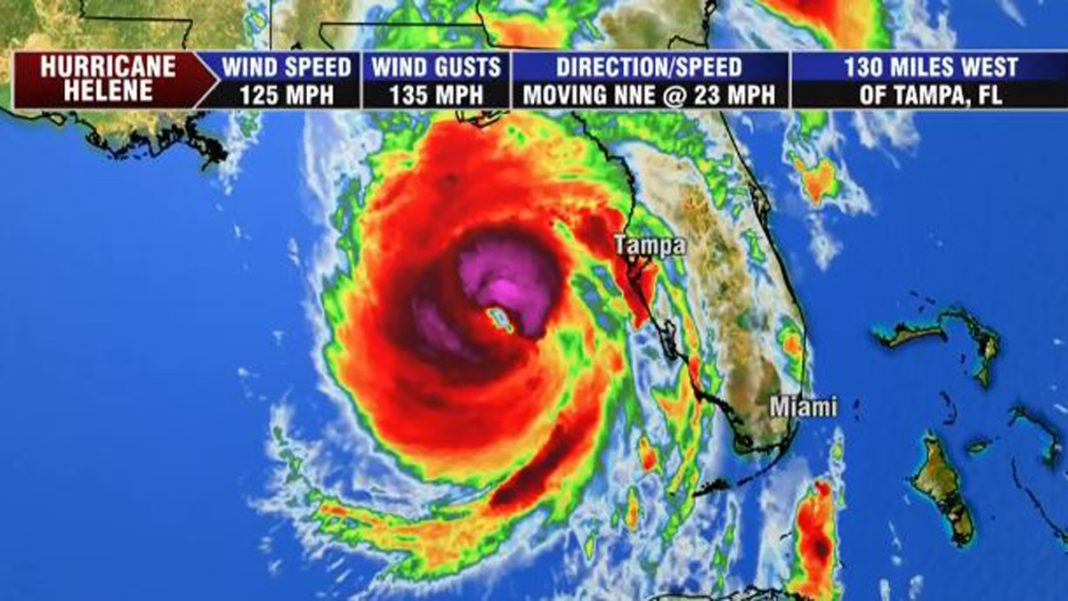As Hurricane Helene barreled toward Florida’s northwest coast, it rapidly intensified into a Category 4 storm, raising alarms across the southeastern United States. Forecasters painted a grim picture, warning of a “nightmare” storm surge and dangerous winds capable of wreaking havoc far beyond the immediate coastal areas. The hurricane’s sheer size and power were reminiscent of past storms, with the potential for catastrophic impacts.
By Thursday evening, Helene was situated approximately 110 miles west of Tampa, churning through the Gulf of Mexico with sustained winds of 130 mph. The U.S. National Hurricane Center reported that the storm was moving north-northeast at a brisk 23 mph, bringing with it life-threatening storm surges that could reach up to 20 feet in the Big Bend area—a region already vulnerable due to its low-lying geography. The implications of such a surge were dire; experts warned that it could lead to flooding unprecedented in the region’s recent history.
In anticipation of the storm’s impact, governors across Florida, Georgia, Alabama, the Carolinas, and Virginia declared states of emergency. This proactive measure was vital as power outages swept through the state, leaving over 320,000 homes and businesses in the dark, according to poweroutage.us. The effects of Helene were already being felt, with reports of rising water levels lapping over roads in areas like Siesta Key and St. Pete Beach.
The storm’s trajectory was particularly concerning for residents of the sparsely populated Big Bend area, known for its picturesque fishing villages and natural beauty. Here, locals were faced with the tough decision of whether to evacuate or ride out the storm. While some, like commercial fisherman Philip Tooke, chose to stay with their livelihoods—his family business rooted in the waters of Apalachee Bay—others were not so fortunate. Sharonda Davis, seeking refuge in a Tallahassee shelter, expressed her fears about her mobile home’s ability to withstand the hurricane’s wrath. “It’s the aftermath that we’re going to have to face,” she stated, highlighting a common anxiety among those living in hurricane-prone areas.
Emergency services were on high alert, with federal authorities staging search-and-rescue teams in anticipation of the storm’s aftermath. The National Weather Service issued urgent advisories, imploring residents to heed evacuation orders and prepare for potential catastrophic flooding. The dire message echoed through social media, urging individuals to inscribe their names and vital information on their bodies in case of separation from loved ones—an unsettling reminder of the storm’s deadly potential.
As the hurricane loomed, local communities braced for impact. Florida’s Forgotten Coast, largely unspoiled by heavy development, faced significant risks. The region’s natural landscapes, characterized by salt marshes and barrier islands, stood vulnerable against the encroaching storm surge. In the wake of Hurricane Michael in 2018, which devastated parts of the Florida Panhandle and caused billions in damage, residents were acutely aware of the risks they faced.
As Helene approached, schools and universities in Georgia canceled classes, and airports across Florida shut down operations. The widespread cancellations were a clear indication of the storm’s seriousness. Georgia Governor Brian Kemp characterized Helene as “one of the biggest storms we’ve ever had,” reflecting the gravity of the situation. Notably, meteorology expert Marshall Shepherd from the University of Georgia warned that this could be the worst storm to hit a major Southern city in 35 years, underscoring the significant threat posed by Helene.
Beyond Florida, the storm’s reach extended to the Appalachian Mountains, where heavy rains threatened to trigger landslides and exacerbate flooding conditions. In North Carolina, forecasters predicted up to 14 inches of rain, setting the stage for potential disasters not seen in a century.
As the Atlantic hurricane season continues, with predictions of above-average activity due to record-warm ocean temperatures, Helene serves as a stark reminder of nature’s wrath. The emergence of Tropical Storm Isaac in the Atlantic and the reformation of former Hurricane John in the Pacific further illustrate the ongoing volatility of this hurricane season.
In conclusion, as communities prepare for the onslaught of Hurricane Helene, the collective focus remains on safety, resilience, and the hope that the storm’s impact will be less severe than anticipated. The lessons learned from previous storms weigh heavily on the minds of residents, reminding them that while they may weather the storm, it is the aftermath that often proves most challenging to navigate.


